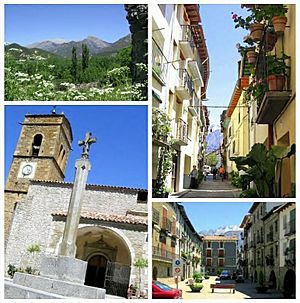Campo, Aragon facts for kids
Campo is a charming town in the Ribagorza area of Huesca province, in Aragon, Spain. It sits in a lovely valley between two rivers, the Esera and Rialbo. High, snowy Pyrenean mountains surround it. The most famous peaks are Turbón (2,492 meters tall) and Cotiella (2,912 meters tall).
Campo's local area also includes a small village called Beleder. Locals often call it Belbedé. It is about 2 kilometers north of Campo.
Contents
Discover Campo: A Mountain Town
Where is Campo Located?
Campo is found in the northeast part of Spain. It is in the region of Aragon. The town is nestled in a valley. This valley is between the Esera River and the Rialbo River. Tall, snow-capped mountains of the Pyrenees surround Campo. These mountains create a beautiful and natural border. Two of the most notable peaks are Turbón and Cotiella. Turbón stands at 2,492 meters high. Cotiella is even taller, reaching 2,912 meters.
What Language Do People Speak in Campo?
Because Campo is surrounded by mountains, it was quite isolated for a long time. This isolation helped keep an old language alive. Locals still speak a special dialect called Patues. People also call it "Fabla". This language is a mix of several older languages. It comes from Vulgar Latin, Navarro-Aragonese, and a southern form of Gascon. It also has influences from Castillian. Speaking Patues is a unique part of Campo's culture. It shows the town's long history.
Famous People from Campo
Campo is the birthplace of an important person named Gaspar Torrente. He was born in 1888 and passed away in 1970. Gaspar Torrente was a key figure in the early 20th century. He worked to promote the unique culture and identity of Aragon. He believed in celebrating what made Aragon special.
Gaspar Torrente's Role
Gaspar Torrente was a founding father of a political party. This party was called 'Estado Aragonés'. He was also a leader of this group. His work helped people in Aragon feel proud of their heritage. He encouraged them to celebrate their history and traditions. He played a big part in shaping the idea of Aragonese identity.
See also
 In Spanish: Campo (Huesca) para niños
In Spanish: Campo (Huesca) para niños


